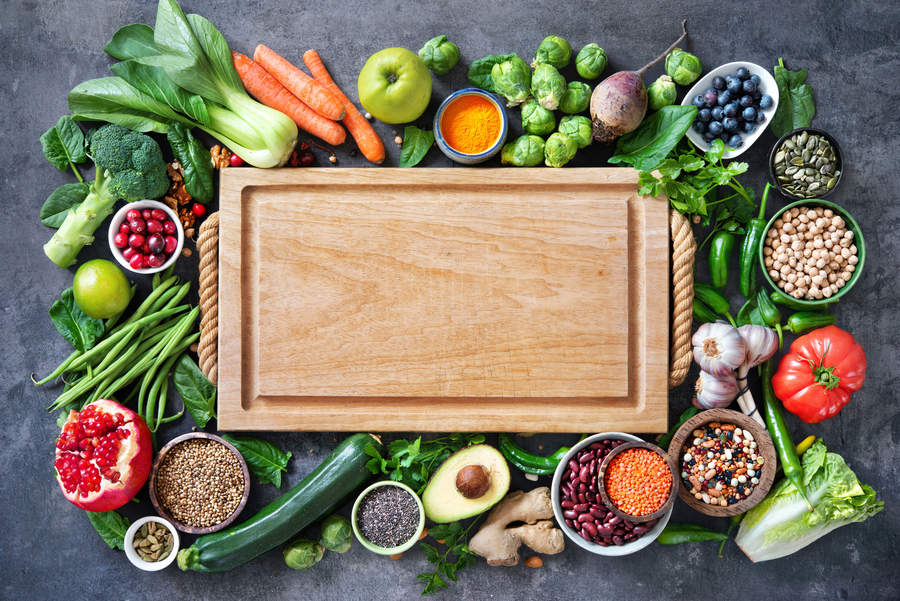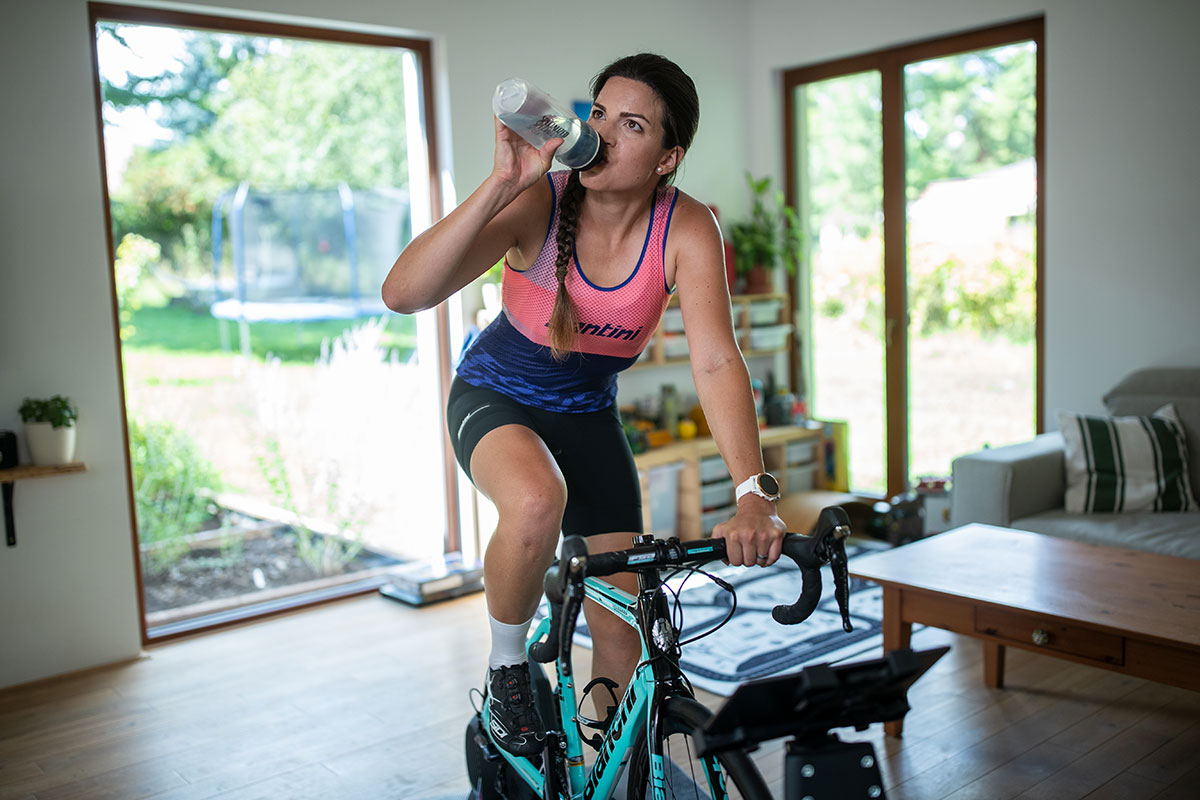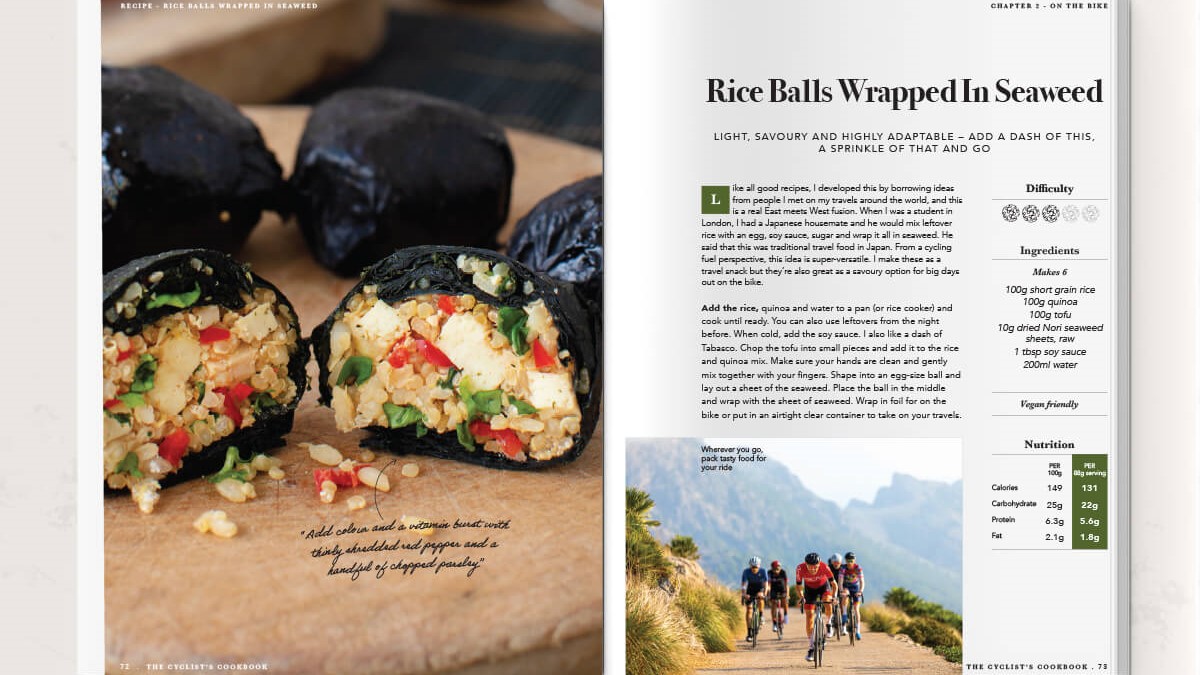Nutrition for indoor cycling: Fuel your workout and perform at your best
Advice from WorldTour nutritionist and dietician Nigel Mitchell, plus some bonus recipes

There's no denying that indoor cycling is here to stay. It has been growing in popularity for a decade, and now, in this post-pandemic era, indoor cycling is an established subdivision of cycling that comes with its own tactical, technical, and nutritional challenges.
On that latter point, if you're wondering whether there is specific nutritional advice for indoor cycling, you're not alone. It's a question posed by many in recent years. It's just cycling, so surely that means it's the same, right? But then again, it's often undertaken in warmer environments, with minimal airflow, doesn't that affect things? We weren't sure, so we asked an expert.
We chatted with Nigel Mitchell, the renowned nutritionist behind numerous WorldTour teams, grand tour wins, and several Olympic gold medals. He’s been closely associated with British Cycling for a long time, and is also the author of ‘The Plant-Based Cyclist’ and ‘Fuelling the Cycling Revolution’, and ‘The Cyclist’s Cookbook’.
So whether you’re completely new to indoor cycling, or you’re a seasoned athlete who’s looking to up the ante this year, if you’re looking for expert advice on the best way to fuel your workouts, you’ve come to the right place.
Does indoor cycling come with its own nutritional requirements?
While this should be a simple question, it is of course the kind that doesn’t come with a simple answer.
Ultimately, the nutritional needs of cycling indoors can differ greatly from those of your regular outdoor cycling, but it's important to know how and when they might differ for you, if they do at all.
Of course, the usual rules of a healthy diet and fuelling workouts still apply. Indoor cycling is, after all, cycling, and a healthy diet is something you can only achieve holistically, rather than merely during the time you spend on the bike. But the environment in which you ride indoors is, by its very nature, different to normal outdoor cycling.
The latest race content, interviews, features, reviews and expert buying guides, direct to your inbox!
However, it's also important to know that your nutrition needs are affected by much more than just where you ride. Your cycling intensity, duration, frequency and location, not to mention any stresses you incur off the bike, will all affect what you need to consume in order to be ready for the next ride.
According to Mitchell: “It all depends on what your objectives are”, he says. “Think about why you’re doing the training that you’re doing. A lot of the work that I do with athletes is around performance planning, and where diet and nutrition fit into that performance plan.”

How to fuel your indoor training
The first consideration, Nigel says, is how long and frequent your training sessions will be, and how ‘serious’ or hard you’ll be working. Naturally, short and easy rides need less fuel than long hard interval sessions, so this needs to be considered.
“Using myself as an example, the purpose of me doing indoor training is because either the weather’s too rubbish or I haven’t got time to get out on the bike. So with my sessions, I try to maximise the physicality, because they tend to be quite short, at less than an hour. In this case, what I will do to fuel or prepare, is an espresso or two before I get on the trainer. That keeps me caffeinated and full of energy. For sessions that last between 40 minutes to an hour, it’s not necessary to snack mid-way. If you need to eat beforehand, then I’d stick to a banana."
For those not keen on coffee, it's worth bearing in mind that many performance nutrition brands will offer energy gels or hydration tablets that contain a similar dose of caffeine to an espresso.
“When I’m working with more serious athletes who are training for up to two or three hours,” Mitchell continues, “Then I’d expect them to regularly snack, starting from about 20-30 minutes into the session, and taking in fuel every 20-30 minutes after that, to keep their blood glucose levels stable, as these will deplete over time. I find that people will get a much better experience of their training that way.”
Exactly what you should eat on the bike will depend on your tastes, but for intense workouts that are burning carbohydrates, you should aim to replenish those first in order to avoid depleting your stores; better known as 'bonking' or 'hitting the wall.'
Most people will already have enough carbohydrates stored in the liver and muscles for around an hour of intense exercise, with trained athletes able to store a little more. Therefore, as Mitchell says, there's little need to consume anything for shorter workouts. It's important to replenish those carbohydrates before your next workout, so consider when that's going to be. If it's not for a day or two, your usual meals will likely replenish your stores just fine.

The best foods for fuel
As mentioned, when you are working hard on the bike you are burning carbohydrates, so the best foods specifically to fuel your work is something high in carbohydrates. Like in all forms of exercise, the accepted science says that the human body can process 90 grams of carbohydrates per hour, when combining of 60g glucose and 30g of fructose. Table sugar is an excellent source, but that doesn't mean you should live on the stuff, as Mitchell explains.
“It may be a bit of a cliché, but one of the things that we tend to say as nutrition professionals is there's no such thing as ‘bad food’, but a ‘bad diet.’ Saying that, when we're working with people who are putting their bodies under a lot of stress, then maximising the nutrition from the food can really help the body to recover and perform. So choose foods that are really nutritionally dense. For example, pure sugar is obviously just pure carbohydrate, but you're not getting any of the other nutrients that the body requires, like B vitamins, potassium, sodium, and things like this.
“Opt for more complex whole foods, and actually combine them together so you get a real variety of different proteins, carbohydrates, and fibres. Fibre is very important when we’re looking at the health of the gut, or the microbiome. So I’d recommend things like mixed grains, which would include quinoa, spelt, pearl barley and rice, and mixing all those together. That’s one of my favourites and a go-to because it’s brilliant and so simple.
“On top of the proteins and complex carbohydrates, you also want to get some essential fats, with omega threes, which are important for helping to regulate some of the stress responses in the body. Avocado is a great source of fat, as well as flax seeds – just be sure to mill them first, otherwise, your body won’t digest them and they’ll go straight through you.
"For protein, I’m a big fan of dairy, but not everyone is. When we consider plant-based proteins, things like soy have a high PDCAAS (protein digestibility-corrected amino acid score), which basically means it’s a high-quality protein source that’s easy to digest.
“We’re understanding now that there are many more fantastic vegetable protein sources as well. Another great one is pistachio nuts, which are super-fats with lots of antioxidants and carotene for our eyes.
“Overall it’d be difficult to just say a specific food, as I believe in combining different foods together to get the nutrients that we need to keep the body active and help us perform and recover better.”

It’s the ultra-processed foods that aren’t great for you.
Which foods to avoid
“It’s the ultra-processed foods that aren’t great for you," Mitchell responds. "When we published The Plant-Based Cyclist, we were shocked by how popular it was, and we’re seeing a lot more people adopting plant-based options, but many are going for ultra-processed plant-based foods; things like burgers, which are very convenient, but also contain stabilisers and caking agents. My mission has always been to try to get people to eat real foods, and think of how we can do that on a very simple and practical basis. Of course, I’m not saying you should never have them, but think about where they’ll fit into your overall diet."
So the advice is to eat real, whole foods, but what about if you’re short on time and unable to cook everything from scratch? Mitchell, being a busy man himself, has a lot of advice on how to make time for cooking healthy meals from scratch.
"I tend to do a lot of batch cooking, using some simple tools like a multicooker that acts as a pressure cooker, rice cooker and slow cooker in one. I’ll cook my porridge in it overnight with a timer so it’s ready when I get up in the morning. Then if you’re heading out to work all day or you’re doing a long training session, you can load up some ingredients and leave it to slow cook or pressure cook your next meal. There are ways to prioritise cooking healthy meals if you plan ahead."

Staying hydrated
As with fuelling, you should consider your hydration as part of a holistic plan, not only something you worry about on the bike, and your needs will depend on the same factors of how hard and how often you train. If you're training hard, long, or often, hydration is an area to pay attention to and get right. You’ll be losing a lot of fluid through sweat, since you won’t have as much of the cooling air that comes with outdoor riding, so you need to make sure you replenish your body of those lost fluids.
In order to know how much fluid you need to replace, you'll need to know how much you're losing, and the best way to do that is to break out the bathroom scales. Our preferred method is to weigh yourself with your filled bottles before you ride, then again afterwards with your likely-empty bottles, and work out the difference in weight. Luckily, 1ml of fluid weighs 1g, so the math is simple. If you're 500g lighter, you should drink 500ml more next time.
It's not just fluid being lost though, electrolytes are also lost through sweat and should be replenished too. Science in Sport's article, 'The Importance Of Hydration' includes advice, as well as a sweat loss calculation to guide you.
If you're wondering what you should eat or drink, there's nothing easier than energy bars, gels and isotonic drink mixes from leading sport endurance brands whose products are aimed specifically at tackling nutrition around exercise.
Most importantly, it's key to revert back to one of the early things that Mitchell said about creating a "performance plan" and how nutrition fits into that. The whole purpose of training - indoors or out - is to improve. The training is the stimulus, but the adaptation (the improvement) comes during recovery. If you train regularly, you need to recover well, and if you finish a session depleted of anything, you'll take longer to recover.
if you’re planning to do another workout in a day or two, and do them regularly, then you need to become very good at recovery and replenishing
Eating to recover
This brings us onto another area of cycling nutrition: recovery.
As mentioned, it's during recovery that adaptation occurs. Training is the stress that breaks down your muscles, and recovery is the point at which they repair, adapting to the stress so that your muscles can better handle it next time around.
In order to rebuild muscle, your body needs protein. The recommended daily allowance is 0.8g per kg of body weight, but more can be tolerated, as Guoyao Wu's 2016 study entitled 'Dietary protein intake and human health' summarised: "Long-term consumption of protein at 2g per kg BW [body weight] per day is safe for healthy adults, and the tolerable upper limit is 3.5 g per kg BW per day for well-adapted subjects.
"Depending on people’s time and what they’ve got to do, they might opt for a recovery drink," Mitchell adds. Recovery drinks and supplements are formulated specifically to aid protein intake, which in turn aids muscle repair and recovery. This is especially important after intense indoor cycling sessions.
Mitchell also advocates homemade drinks, which can be used in addition to or instead of dedicated recovery supplements. "This is something very easy to make yourself, or actually, you might want more of a food-based option, which can be really easy.
"If you’re doing a turbo session in the morning, before breakfast, then you can follow it up with my super porridge recipe, that’s got things like quinoa and flax in it, and that will be great, because it’s got all the carbohydrates and proteins and is more nutritionally diverse.
"For later in the day, you could prepare my recovery beef stew in the slow cooker, or for plant-based options, there’s the tofu risotto which is amazing because it’s made with multiple whole grains and not just rice, so it makes a great recovery meal.
"The most important thing is that after you’ve done something that’s been quite depleting or damaging, if you’re planning to do another workout in a day or two, and do them regularly, then you need to become very good at recovery and replenishing. It’s not as critical if you’re only training once a week, though."

Oreo Rice Cakes recipe
If you like these, there are five other variations in The Cyclist’s Cookbook, including Salted Caramel Dairy Free Rice Cakes, Pistachio Rice Cakes, and Parma Ham & Parmesan Cheese Rice Cakes.
Makes: 20
Ingredients:
- 500g short grain pudding rice
- 24g (2 tbsp) coconut oil
- 25g (2 tbsp) white sugar
- 1litre water
- 300g cream cheese
- 55g (5 biscuits) crushed Oreo biscuits
Method:
Place the rice, water, vanilla, sugar, water and coconut oil into a rice cooker, fold in the crushed biscuits, and follow the manufacturer’s instructions.
Or, put them all in a large saucepan and follow the cooking instructions on the rice packet. The crucial thing is to have the correct ratio of one part rice to two parts water.
When cooked, mix in the cream cheese. Spoon into a zip-seal freezer bag (size large or medium depending on the brand), flatten and smooth the air out. Leave to cool on a flat tray and, once cool, refrigerate overnight.
Cut into approximately 20 squares and keep in an airtight container in the fridge. If refrigerated they will keep for about four days, or you can divide the ingredients in half to make half a batch.

Josh is Associate Editor of Cyclingnews – leading our content on the best bikes, kit and the latest breaking tech stories from the pro peloton. He has been with us since the summer of 2019 and throughout that time he's covered everything from buyer's guides and deals to the latest tech news and reviews.
On the bike, Josh has been riding and racing for over 15 years. He started out racing cross country in his teens back when 26-inch wheels and triple chainsets were still mainstream, but he found favour in road racing in his early 20s, racing at a local and national level for Somerset-based Team Tor 2000. These days he rides indoors for convenience and fitness, and outdoors for fun on road, gravel, 'cross and cross-country bikes, the latter usually with his two dogs in tow.